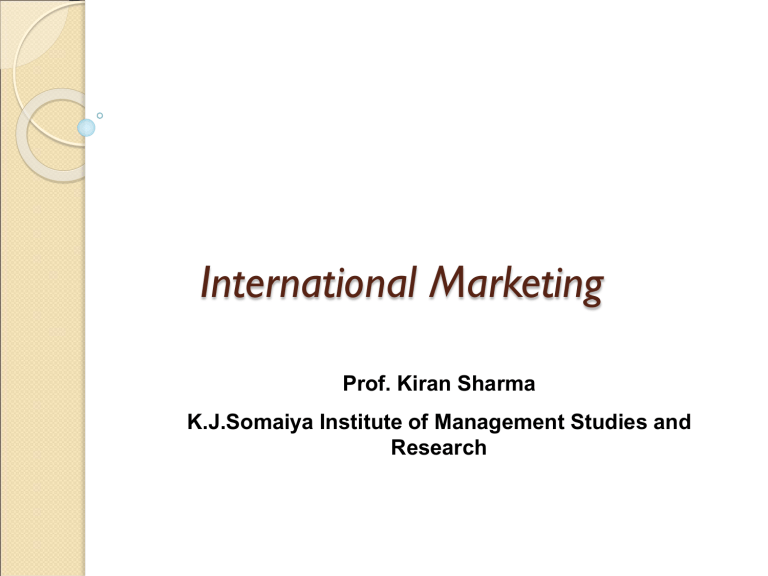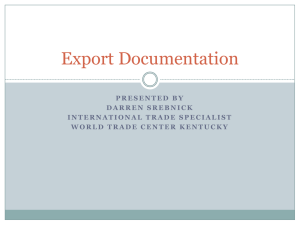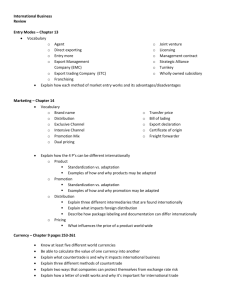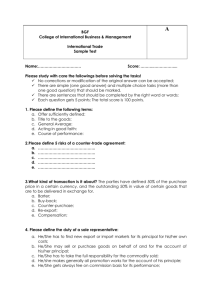International Marketing

International Marketing
Prof. Kiran Sharma
K.J.Somaiya Institute of Management Studies and
Research
Global Perspective: Recent Events
Information technology boom of the late 1990s
The high-tech bust of 2001
Enron scandal
September 11th attacks on the World Trade
Center and Pentagon
Wars in Afghanistan and Iraq
Global Perspective: Recent Events
International conflict among China,
Taiwan, and the United States
2003 SARS outbreak in Asia
Global terrorism, e.g., Indonesia, London,India, and Pakistan
Transcending these events, international
commerce continued
Global Business Trends
1. The rapid growth of the
World Trade Organization and regional free trade areas, e.g., NAFTA and the
European Union
2. General acceptance of the free market system among developing countries in Latin
America, Asia, and Eastern
Europe
3. Impact of the Internet and other global media on the dissolution of national borders, and
4. Managing global environmental resources
International Marketing: A Definition
International marketing is defined as the performance of business activities designed to plan, price, promote, and direct the flow of a company’s goods and services to consumers or users in more than one nation for a profit
Marketing concepts, processes, and principles are universally applicable all over the world
The International Marketing Task
Foreign Environment
(Uncontrollables)
7. Structure of
Distribution
6. Geography and
Infrastructure
1. Competition
Domestic environment
(Uncontrollables)
(Controllables) 1. Competition
Environmental
Uncontrollables country market A
3. Political-
Legal
Price
Target
Product
Market
Promotion Place or
7
Distribution
2. Technology
Environmental uncontrollables country market B
5. Political-
Legal
2. Economy
3. Economy
Environmental uncontrollables country market C
4. Culture
Environmental Adaptation Needed
Differences are in the uncontrollable environment of international marketing
Firms must adapt to uncontrollable environment of international marketing by adjusting the marketing mix (product, price, promotion, and distribution)
Continuum
Adaptation
(of Marketing Mix)
Standardization
(of Marketing Mix)
INFLUENCED BY 7 ENVIRONMENTAL FACTORS
Developing a Global Awareness
To be globally aware is to have:
1.
Tolerance of Cultural Differences, and
2. Knowledgeable of:
(a) Culture, (b) History, (c) World Market Potential,
(d) Global Economic, Social and Political Trends
Stages of International Marketing
Involvement
In general, firms go through five different phases in going international:
No Direct Foreign Marketing
Infrequent Foreign Marketing
Regular Foreign Marketing
International Marketing
Global Marketing
Strategic Orientation: EPRG Schema
Orientation EPRG Schema
(Ethnocentric) Domestic Marketing
Extension
Multi-Domestic
Marketing
Global Marketing
(Polycentric)
(Regio/Geocentric)
Strategic Orientation: EPRG Schema
Generally, four distinctive approaches dominate strategic thinking in international marketing:
1. Ethnocentric or Domestic Marketing Extension Concept:
Home country is superior to rest of the world.
Assumes that products and practices will succeed anywhere in the world as they have been in home country.
2. Polycentric or Multi-Domestic Marketing Concept:
Opposite of ethnocentrism
Management believes that each country is unique and allows each to develop own marketing strategies locally.
Leads to adaptation approach where products must be adopted in response to different market conditions.
Strategic Orientation: EPRG Schema
Generally, four distinctive approaches dominate strategic thinking in international marketing:
3. Regiocentric:
A region becomes the relevant geographic unit.
Management’s role is to develop an integrated regional strategy.
4. Geocentric:
Company views the entire world as a potential market and strives to develop integrated world market wherein a uniform, standardized marketing strategy is used for several countries, countries in a region, or the entire world.
Foreign Market-Entry Strategies
When a company makes the commitment to go international, it must choose an entry strategy
The choice of entry strategy depends on:
• market characteristics (such as potential sales, strategic importance, cultural differences, and country restrictions)
• company capabilities and characteristics, including the degree of near-market knowledge, marketing involvement, and
• commitment that management is prepared to make
Alternative Market-Entry Strategies
•
Import regulations may be imposed to protect health, conserve foreign exchange, protect home industry, or provide revenue in the form of tariffs
•
A company has four different modes of foreign market entry from which to select:
• exporting
• contractual agreements
• strategic alliances, and
• direct foreign investment
Exporting
• Exporting can be either direct or indirect
• In direct exporting the company sells to a customer in another country
• In contrast, indirect exporting usually means that the company sells to a buyer (importer or distributor) in the home country who in turn exports the product
•
The Internet is becoming increasingly important as a foreign market entry method
Contractual Agreements
Contractual agreements are long-term, non-equity associations between a company and another in a foreign market
•
Contractual agreements generally involve the transfer of technology, processes, trademarks, or human skills
•
Contractual forms of market entry include:
(1) Licensing: A means of establishing a foothold in foreign markets without large capital outlays wherein patent rights, trademark rights and the rights to use technological processes are granted.
(2) Franchising: A contract in which franchisor provides a standard package of products, systems and management systems and franchisee provides market knowledge, capital and personal involvement.
Strategic International Alliances
•
Strategic alliances have grown in importance over the last few decades as a competitive strategy in global marketing management
•
A strategic international alliance (SIA) is a business relationship established by two or more companies to cooperate out of mutual need and to share risk in achieving a common objective
•
SIAs are sought as a way to shore up weaknesses and increase competitive strengths
•
SIAs offer opportunities for rapid expansion into new markets, access to new technology, more efficient production and marketing costs
•
An example of SIAs in the airlines industry is that of the alliance partners made up of American Airlines, Cathay Pacific, British
Airways, Canadian Airlines.
International Joint Ventures
• International joint ventures (IJVs) have been increasingly used since 1970s
• a means of lessening political and economic risks by the amount of the partner’s contribution to the venture
• a less risky way to enter markets
•
A joint venture is different from strategic alliances or collaborative relationships in that a joint venture is a partnership of two or more participating companies that have joined forces to create a separate legal entity
International Joint Ventures (contd.)
• Four factors are associated with joint ventures:
1.
JVs are established, separate, legal entities;
2.
they acknowledge intent by the partners to share in the management of the JV;
3.
they are partnerships between legally incorporated entities such as companies, chartered organizations, or governments, and not between individuals;
4.
equity positions are held by each of the partners
Consortia
• Consortia are similar to joint ventures and could be classified as such except for two unique characteristics:
(1) They typically involve a large number of participants, and
(2) They frequently operate in a country or market in which none of the participants is currently active
•
Consortia are developed to pool financial and managerial resources and to lessen risks.
Direct Foreign Investment
•
A fourth means of foreign market development and entry is direct foreign investment
•
Companies may manufacture locally to capitalize on low-cost labor, to avoid high import taxes, to reduce the high costs of transportation to market, to gain access to raw materials, or as a means of gaining market entry.
• Firms may either invest in or buy local companies or establish new operations facilities
Export Procedures and
Documentation
Export procedures and documetation
•
Export procedures and documentation are crucial to international marketing, as both exporters and importers are situated in two different countries and are governed by different legislative frameworks
• Export documentation facilitates international transactions and protects the interest of the exporters and importers
Types of export documents
•
Commercial documents are used by ‘custom of trade’ in international commerce by exporters and importers in discharge of their respective legal and other incidental responsibilities under sales contract.
•
Regulatory documents are prescribed by different government departments / bodies for compliance of formalities under relevant laws
Eg: Commodities ( Agri) – PHYTO certificate
Pharmaceuticals –
PLANT approval( US FDA, UK MHRA, TG Australia, WHO GMP)
PRODUCT –
•
Free sale certificate issued by FDA India, validity 3 years
•
EXPORTS Manufacturing License (Domestic) + Certificate of Pharmaceutical
Product(COPP)
•
Quality Control Labs Must follow GLP (Good laboratory Procedures)
•
Certificate of Analysis mentioning heavy metal content (Pb, Cd, As, Hg)
•
Material Safety Data Sheet (MSDS) asked by carrier
•
Bioequivalence Studies ( Atorvastatin vs. Lipitor)
•
Stability/ Efficacy Studies in different temperature zones
Commercial documents
•
Commercial invoice is a document of content that provides:
- identification of shipment
- detailed description of goods
- description of quantity
•
Packing list provides details of how the goods are packed, the contents of different boxes, cartons, or bales, and details of the weights and measurement of each package in the consignment
• Transport documents that evidence shipment of goods, such as bill of lading, combined transport document.
Bill of lading
•
Marine bill of lading (B/L)
- a transport document issued by the shipping company to the shipper for accepting the goods for the carriage of merchandise
•
Airway bill (AWB)
- issued by the carrier as an evidence of contract of carriage
• Bill of lading serves three purposes:
- it is the receipt of cargo by the shipping company
- a contract of carriage (or transport)
- a document of title
Types of Bill of lading
On board or shipped bill of lading
Received for shipment bill of lading
Clean bill of lading
Dirty (clause) bill of lading
Through bill of lading
Trans-shipment bill of lading
Certificate of origin
used as an evidence of the origin of goods in the importing country
includes the details of the goods covered and the country where the goods are grown, produced or manufactured
Other Documents of Importance
•
Inspection certificate is related to quality of goods
•
Insurance certificate provides protection to the cargo-owner, an insurance cover is necessary while the cargo is in transit from the consignor to the consignee
• Mate’s receipt is a cargo receipt issued by the master of the vessel for every shipment taken on board
•
Bill of exchange is an unconditional order in writing prepared and signed by the exporter addressed to the importer requiring the importer to pay a certain sum of money to the exporter or his / her nominee
•
Shipment advice is sent to the importer informing of the details of the shipment
•
S hipping bill / bill of export is the principal document required by customs authority mentioning details of shipment for exports
• Bill of entry is a document needed for customs clearance of imported cargo
Procedure for export-import
• compliance with legal framework
• obtaining import-export code number
• registration with export promotion council
• registration with sales tax and central excise authorities
• concluding an export deal
• arranging export finance
• appointing C& F Agent
• manufacturing of goods
• arranging cargo insurance
• port procedures and customs clearance
• presentation of documents at the negotiating bank
• claiming export incentives( Duty Drawback)
• receiving payment and export incentives
Electronic processing of export documents
• use information technology in the field of international business has facilitated computerized generation and processing of export documents
• for electronic filing and processing of documents,
Indian customs and central excise electronic commerce
/ electronic data interchange (EC /EDI) gateway has been created, popularly known as ICEGATE
Terms Of payment in
International transactions
Terms Of Payments
Advance payment
Open account
Consignment (Payment after sale of goods)
Documentary credit
Documentary credit without Letter of Credit
Sight Drafts (Documents against payment)
Usance or time Draft (Documents against acceptance)
Types of credit according to methods of payments
Documentary credit with letter of credit
•Irrevocable- No change, modification or cancellation)
•Revocable – Change possible
•Confirmed
•Unconfirmed
Revolving Credit
Back to back





